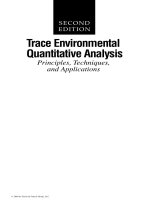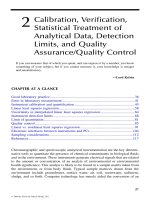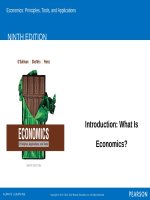Economics principles tools and applications 9th by sullivan sheffrin perez chapter 27
Bạn đang xem bản rút gọn của tài liệu. Xem và tải ngay bản đầy đủ của tài liệu tại đây (875.83 KB, 33 trang )
Economics
NINTH EDITION
Chapter 27
Oligopoly and Strategic
Behavior
Copyright © 2015, 2012, 2009 Pearson Education, Inc. All Rights Reserved
Learning Objectives
27.1 Explain why a price-fixing cartel is difficult to maintain.
27.2 Explain the effects of a low-price guarantee on the price.
27.3 Describe the prisoners' dilemma.
27.4 Explain the behavior of an insecure monopolist.
27.5 Explain two advertisers dilemmas.
Copyright © 2015, 2012, 2009 Pearson Education, Inc. All Rights Reserved
Oligopoly and Strategic Behavior
●
Oligopoly
A market served by a few firms.
●
Game theory
The study of decision making in strategic situations.
Copyright © 2015, 2012, 2009 Pearson Education, Inc. All Rights Reserved
WHAT IS AN OLIGOPOLY? (1 of 2)
●
Concentration ratio
The percentage of the market output produced by the largest firms.
An alternative measure of market concentration is the Herfindahl-Hirschman Index (HHI). It is calculated by squaring the market share of each firm in the
market and then summing the resulting numbers.
An oligopoly—a market with just a few firms—occurs for three reasons:
1. Government barriers to entry
.
2. Economies of scale in production.
3. Advertising campaigns.
Copyright © 2015, 2012, 2009 Pearson Education, Inc. All Rights Reserved
WHAT IS AN OLIGOPOLY? (2 of 2)
TABLE 27.1 Concentration Ratios in Selected Manufacturing Industries
Four-Firm Concentration
Eight-Firm Concentration
Ratio (%)
Ratio (%)
Primary copper smelting
99
Not available
House slippers
97
99
Guided missiles and space vehicles
96
99
Cigarettes
95
99
Soybean processing
95
99
Household laundry equipment
93
Not available
Breweries
91
94
Electric lamp bulbs
89
90
Military vehicles
88
93
Primary battery manufacturing
87
99
Beet sugar processing
85
98
Household refrigerators and freezers
85
95
Small arms (weapons)
84
90
Breakfast cereals
82
93
Motor vehicles and car bodies
81
91
Not available
89
Industry
Flavoring syrup
SOURCE: U.S. Bureau of the Census, 2002 Economic Census, Manufacturing, Concentration Ratios: 2002
(Washington, D.C.: U.S. Government Printing Office, 2006).
Copyright © 2015, 2012, 2009 Pearson Education, Inc. All Rights Reserved
27.1 CARTEL PRICING AND THE
DUOPOLISTS’ DILEMMA (1 of 7)
●
Duopoly
A market with two firms.
●
Cartel
A group of firms that act in unison, coordinating their price and quantity decisions.
Copyright © 2015, 2012, 2009 Pearson Education, Inc. All Rights Reserved
27.1 CARTEL PRICING AND THE
DUOPOLISTS’ DILEMMA (2 of 7)
Profit = (price − average cost) × quantity per firm
The monopoly outcome is shown by point a, where marginal revenue
equals marginal cost.
The monopoly quantity is 60 passengers and the price is $400. If the firms
form a cartel, the price is $400 and each firm has 30 passengers (half the
monopoly quantity).
The profit per passenger is $300 (equal to the $400 price minus the $100
average cost), so the profit per firm is $9,000.
●
Price-fixing
An arrangement in which firms conspire to fix prices.
Copyright © 2015, 2012, 2009 Pearson Education, Inc. All Rights Reserved
27.1 CARTEL PRICING AND THE
DUOPOLISTS’ DILEMMA (3 of 7)
(A) The typical firm maximizes profit at point a, where
marginal revenue equals marginal cost. The firm has 40
passengers.
(B) At the market level, the duopoly outcome is shown by
point d, with a price of $300 and
80 passengers. The cartel outcome, shown by point c, has a
higher price and a smaller total quantity.
Copyright © 2015, 2012, 2009 Pearson Education, Inc. All Rights Reserved
27.1 CARTEL PRICING AND THE
DUOPOLISTS’ DILEMMA (4 of 7)
Price-Fixing and the Game Tree
●
Game tree
A graphical representation of the consequences of different
actions in a strategic setting.
The equilibrium path of the game is square A to square C to rectangle
4: Each firm picks the low price and earns a profit of $8,000.
The duopolists’ dilemma is that each firm would make more profit if
both picked the high price, but both firms pick the low price.
Copyright © 2015, 2012, 2009 Pearson Education, Inc. All Rights Reserved
27.1 CARTEL PRICING AND THE
DUOPOLISTS’ DILEMMA (5 of 7)
Price-Fixing and the Game Tree
TABLE 27.2 Duopolists’ Profits When They Choose Different Prices
Jill: High Price
Jack: Low Price
Price
$ 400
$ 300
Average cost
$ 100
$ 100
Profit per passenger
$ 300
$ 200
10
60
$3,000
$12,000
Number of passengers
Profit
Copyright © 2015, 2012, 2009 Pearson Education, Inc. All Rights Reserved
27.1 CARTEL PRICING AND THE
DUOPOLISTS’ DILEMMA (6 of 7)
Equilibrium of the Price-Fixing Game
●
Dominant strategy
An action that is the best choice for a player, no matter what the other player does.
●
Duopolists’ dilemma
A situation in which both firms in a market would be better off if both chose the high price, but each chooses the low price.
Copyright © 2015, 2012, 2009 Pearson Education, Inc. All Rights Reserved
27.1 CARTEL PRICING AND THE
DUOPOLISTS’ DILEMMA (7 of 7)
Nash Equilibrium
●
Nash equilibrium
An outcome of a game in which each player is doing the best he or she can, given the action of the other players.
Copyright © 2015, 2012, 2009 Pearson Education, Inc. All Rights Reserved
APPLICATION 1
FAILURE OF THE SALT CARTEL
APPLYING THE CONCEPTS #1: Why do cartels sometimes fail to keep price high?
•
At the beginning of the 19th Century, high overland transportation costs protected salt producers from competition with one another, generating local salt
monopolies. Over the course of the 19th Century, decreases in overland transportation costs increased competition between salt producers and decreased
prices.
•
In response to the increased competition, salt producers in a particular state colluded by forming a salt pool, enterprises that set a uniform price and
distributed the salt of all participating producers. Some pools established output quotas or paid firms not to produce salt for a year, a practice known as
“dead-renting” a salt furnace.
•
Every pool arrangement broke down, usually within a year or two of its formation. In some cases, individual firms cheated on the cartel by selling salt
outside the cartel. In other cases the artificially high price caused new firms to enter the market and underprice the salt pool.
Copyright © 2015, 2012, 2009 Pearson Education, Inc. All Rights Reserved
27.2 OVERCOMING THE
DUOPOLISTS’ DILEMMA (1 of 6)
Low-Price Guarantees
●
Low-price guarantee
A promise to match a lower price of a competitor.
Copyright © 2015, 2012, 2009 Pearson Education, Inc. All Rights Reserved
27.2 OVERCOMING THE
DUOPOLISTS’ DILEMMA (2 of 6)
Low-Price Guarantees
When both firms have a low-price guarantee, it is impossible for
one firm to underprice the other. The only possible outcomes
are a pair of high prices (rectangle 1) or a pair of low prices
(rectangles 2 or 4).
The equilibrium path of the game is square A to square B to
rectangle 1. Each firm picks the high price and earns a profit of
$9,000.
Copyright © 2015, 2012, 2009 Pearson Education, Inc. All Rights Reserved
27.2 OVERCOMING THE
DUOPOLISTS’ DILEMMA (3 of 6)
Repeated Pricing Games with Retaliation for Underpricing
Repetition makes price-fixing more likely because firms can punish a firm that cheats on a price-fixing agreement, whether it’s formal or informal:
1
A duopoly pricing strategy.
Choosing the lower price for life.
2
A grim-trigger strategy.
●
Grim-trigger strategy
A strategy where a firm responds to underpricing by choosing a price so low
that each
firm makes zero economic profit.
3
A tit-for-tat strategy.
●
Tit-for-tat
A strategy where one firm chooses whatever price the other firm chose in the
preceding period.
Copyright © 2015, 2012, 2009 Pearson Education, Inc. All Rights Reserved
27.2 OVERCOMING THE
DUOPOLISTS’ DILEMMA (4 of 6)
Repeated Pricing Games with Retaliation for
Underpricing
Under tit-for-tat retaliation, the first firm (Jill, the square) chooses
whatever price the second firm (Jack, the circle) chose the
preceding month.
Copyright © 2015, 2012, 2009 Pearson Education, Inc. All Rights Reserved
27.2 OVERCOMING THE
DUOPOLISTS’ DILEMMA (5 of 6)
Price-Fixing and the Law
•
Under the Sherman Antitrust Act of 1890 and subsequent legislation, explicit price-fixing is illegal. It is illegal for firms to discuss pricing strategies or
methods of punishing a firm that underprices other firms.
Copyright © 2015, 2012, 2009 Pearson Education, Inc. All Rights Reserved
27.2 OVERCOMING THE
DUOPOLISTS’ DILEMMA (6 of 6)
Price Leadership
●
Price leadership
A system under which one firm in an oligopoly takes the lead in setting prices.
The problem with an implicit pricing agreement is that it relies on indirect signals that are often garbled and misinterpreted. When one firm suddenly drops its
price, the other firm could interpret the price cut in one of two ways:
•
A change in market conditions.
•
Underpricing.
Copyright © 2015, 2012, 2009 Pearson Education, Inc. All Rights Reserved
APPLICATION 2
•
LOW-PRICE GUARANTEE INCREASES TIRE PRICES
•
APPLYING THE CONCEPTS #2: Do low price guarantees generate higher or lower prices?
•
In two successive months (November and December), a Florida tire retailer listed prices for 35 types of tires in newspaper advertisements. In November
the average price was $45, and in December the average price was $55.
•
The December advertisement was different in another way: it included a low-price guarantee under which the retailer agreed to match any lower
advertised price (and also pay the customer some percentage of the price gap). In fact, for each of the 35 types of tires, the December price was the same
or higher than the November price. In this case, a low-price guarantee generated higher prices.
•
Is the relationship between low-price guarantees and prices apparent or real? A careful study of the retail tire market suggests that prices are generally
higher in markets where firms offer low-price guarantees. On average, the presence of a low-price guarantee increases prices by a modest $4 per tire, or
about 10 percent of the price.
Copyright © 2015, 2012, 2009 Pearson Education, Inc. All Rights Reserved
27.3 SIMULTANEOUS DECISION MAKING AND THE PAYOFF MATRIX (1 of 3)
●
Payoff matrix
A matrix or table that shows, for each possible outcome of a game, the consequences for each player.
Copyright © 2015, 2012, 2009 Pearson Education, Inc. All Rights Reserved
27.3 SIMULTANEOUS DECISION MAKING AND THE PAYOFF MATRIX (2 of 3)
Simultaneous Price-Fixing Game
Jill’s profit is in red, and Jack’s profit is in blue.
If both firms pick the high price, each firm earns a profit of $9,000.
Both firms will pick the low price, and each firm will earn a profit of
only $8,000.
Copyright © 2015, 2012, 2009 Pearson Education, Inc. All Rights Reserved
27.3 SIMULTANEOUS DECISION MAKING AND THE PAYOFF MATRIX (2 of 3)
The Prisoners’ Dilemma
The prisoners’ dilemma is that each prisoner would be better off
if neither confessed, but both people confess.
The Nash equilibrium is shown in the southeast corner of the
matrix. Each person gets five years of prison time.
Copyright © 2015, 2012, 2009 Pearson Education, Inc. All Rights Reserved
APPLICATION 3
•
CHEATING ON THE FINAL EXAM: THE CHEATERS’ DILEMMA
•
APPLYING THE CONCEPTS #3: When does cooperation break down?
•
An economics professor discovered three students cheating on the final.
•
Speaking to them individually, he gave each student two options
•
If the student confessed, he or she would receive a zero on the exam, but suffer no other consequences.
•
If they did not confess, he or she would go before the Office of Student Judicial Affairs, and any confessions by the other two students would be used as
evidence.
•
Is this a prisoner’s dilemma?
•
What is the likely outcome?
Copyright © 2015, 2012, 2009 Pearson Education, Inc. All Rights Reserved
27.4 THE INSECURE MONOPOLIST AND ENTRY DETERRENCE (1 of 5)
Point c shows a secure monopoly, point d shows a duopoly, and
point z shows the zero-profit outcome.
The minimum entry quantity is 20 passengers, so the entrydeterring quantity is 100 (equal to 120 – 20), as shown by point e.
The limit price is $200.
Copyright © 2015, 2012, 2009 Pearson Education, Inc. All Rights Reserved









